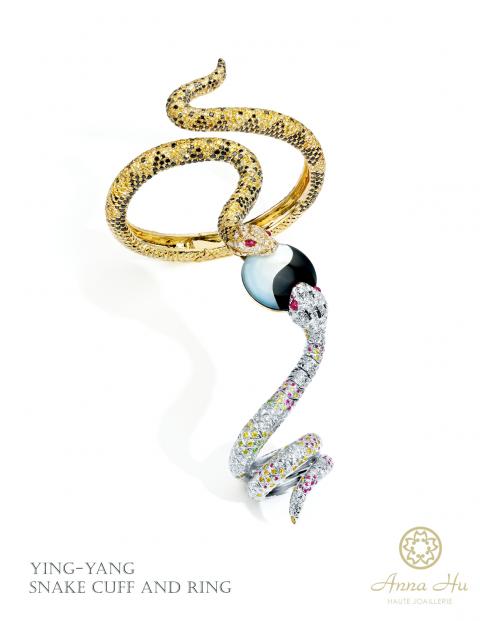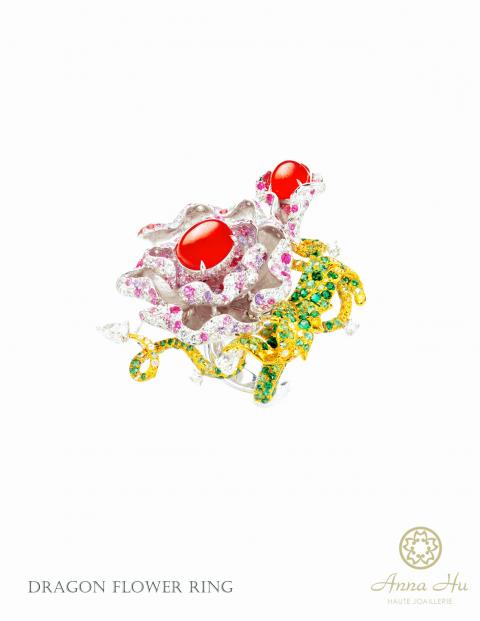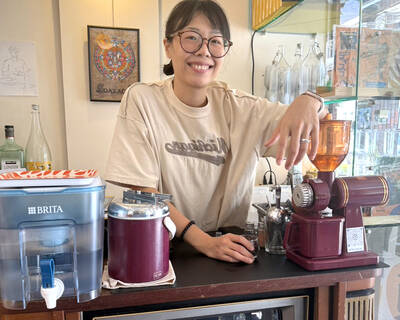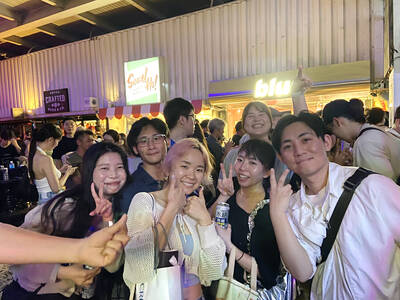Anna Hu (胡茵菲) had her heart set on a career as a cellist until a shoulder injury cut short her musical aspirations. Now the 34-year-old shines as a jeweler whose luxurious, art-inspired designs have attracted clients ranging from Cindy Sherman to Madonna. Her creations also make regular appearances on the red carpet, including February’s Academy Awards, where Scarlett Johansson and Hilary Swank wore pieces that paid homage to Surrealist paintings.
Though she launched New York City-based Anna Hu Haute Joaillerie just four years ago, Hu has already garnered high praise among jewelry connoisseurs and collectors. In a Wall Street Journal profile, David Warren, the director of Christie’s in London and the Middle East, said Hu is considered among the top five or six contemporary jewelry designers in the world.
Born in Taiwan, Hu immigrated to the US with her family when she was a teenager. Though both her parents worked in the jewelry trade, Hu’s first passion was classical music.

Photos courtesy of Anna Hu Haute Joaillerie
“Before I hurt my shoulder, my whole life was about the cello,” says Hu, who practiced at least five hours a day before developing tendinitis. Her chiropractor ordered her to reduce her playing time to half an hour.
With her musical career on hold, Hu felt “very empty.”
“It was in 1997, right around my birthday in March, and for two months it was like hell for me,” she says.

Photo Courtesy of Anna Hu Haute Joaillerie
Then her father, a diamond dealer, suggested that she take a jewelry design class to help lift her out of her depression.
“It was like a transformation for me,” Hu says. “I learned that it doesn’t matter if it’s performing arts or visual arts, it’s all universal.”
Hu, who earned master’s degrees in art history and art administration from the Parsons School of Design and Columbia University, now applies the same perfectionist tendencies to her jewelry that she did to the cello. She cites artists Vincent van Gogh, Gustav Klimt and Chang Dai-chien (張大千) as inspirations; her favorite jeweler is Rene Lalique.

Photo Courtesy of Anna Hu Haute Joaillerie
Despite her celebrity clientele, Hu lays down the law for her custom work and insists on creating pieces that reflect her aesthetic point of view.
“I don’t care if someone is rich or whatever their status is, I don’t give a damn,” Hu says. “They come to me, they listen to me.”
She compares the process of designing a piece of jewelry to composing a symphony.

Photo Courtesy of Anna Hu Haute Joaillerie
“Every gemstone is like a musical note. The contours, the shapes, the lines, are like the melody,” Hu says. “The setting technique, the wax modeling and the construction of the jewelry is really like musical theory, it’s like the rhythm.”
Hu listens to the same pieces of classical music over and over again while working. Johann Sebastian Bach’s concertos are “very symmetrical, very structured, with a lot of symmetry” and inspire her when she creates art deco designs.
Frederic Chopin was her composer of choice while making the bold, lushly detailed jewelry Johansson and Swank wore to the Oscars.
“I related them to Chopin, because they are ultra-romantic and very passionate, with organic curvilinear lines,” Hu says.
Crafted by jewelers in New York City and Paris, Hu’s pieces can take years from conception to the final product. One of Hu’s newest showcase creations, a dramatic collar set with hundreds of precious stones in delicate shades inspired by the artwork of Claude Monet, hails back to a trip Hu made to Giverny, France, when she was 21 years old.
Afterward, she visited the Musee d’Orsay and the Museum of Modern Art in New York City to study Monet’s water lily paintings. While working on the necklace, Hu only listened to works by Impressionist composers Maurice Ravel and Claude Debussy.
The setting of the Monet Water Lily Necklace, which includes various gems in a spectrum of soft, watercolor-like colors offset by glittering diamonds of varying sizes, took more than two years to finish.
Hu began with a sketch before picking different jewels for the piece, treating the precious stones like pigment as she laid them out in a wax model.
When Hu showed the stunningly extravagant final creation to her father, who supplies all her jewels, his jaw dropped.
“We bought all these amazing gemstones and he said, ‘I think you can do about a hundred pieces with them,’” Hu says. “He was expecting a hundred different designs and I put them all into one.”
She has already decided that she will make 999 one-of-a-kind pieces before she retires (the Mandarin pronunciation of nine is a homophone for “longevity”) and organize a solo exhibition of her jewelry every five years. She figures that her plan will keep her busy until she is 75 years old.
“It’s all connected, from music to painting to jewelry. It makes sense to me,” Hu says. “I just feel like I am in another world.”
For more information: www.anna-hu.com

Cheng Ching-hsiang (鄭青祥) turned a small triangle of concrete jammed between two old shops into a cool little bar called 9dimension. In front of the shop, a steampunk-like structure was welded by himself to serve as a booth where he prepares cocktails. “Yancheng used to be just old people,” he says, “but now young people are coming and creating the New Yancheng.” Around the corner, Yu Hsiu-jao (饒毓琇), opened Tiny Cafe. True to its name, it is the size of a cupboard and serves cold-brewed coffee. “Small shops are so special and have personality,” she says, “people come to Yancheng to find such treasures.” She

Late last month Philippines Foreign Affairs Secretary Theresa Lazaro told the Philippine Senate that the nation has sufficient funds to evacuate the nearly 170,000 Filipino residents in Taiwan, 84 percent of whom are migrant workers, in the event of war. Agencies have been exploring evacuation scenarios since early this year, she said. She also observed that since the Philippines has only limited ships, the government is consulting security agencies for alternatives. Filipinos are a distant third in overall migrant worker population. Indonesia has over 248,000 workers, followed by roughly 240,000 Vietnamese. It should be noted that there are another 170,000

Hannah Liao (廖宸萱) recalls the harassment she experienced on dating apps, an experience that left her frightened and disgusted. “I’ve tried some voice-based dating apps,” the 30-year-old says. “Right away, some guys would say things like, ‘Wanna talk dirty?’ or ‘Wanna suck my d**k?’” she says. Liao’s story is not unique. Ministry of Health and Welfare statistics show a more than 50 percent rise in sexual assault cases related to online encounters over the past five years. In 2023 alone, women comprised 7,698 of the 9,413 reported victims. Faced with a dating landscape that can feel more predatory than promising, many in

“This is one of those rare bits of TikTok fitness advice with a lot of truth behind it,” says Bethan Crouse, performance nutritionist at Loughborough University. “Sometimes it’s taken a bit too literally, though! You see people chugging protein drinks as they’re scanning out of their gym.” Crouse recommends the athletes she works with consume 20-30g of protein within 30-60 minutes of finishing a resistance training session. “The act of exercising our muscles increases the breakdown of muscle proteins,” she says. “In order to restore, or hopefully improve them — and get gains such as increased muscle mass or strength —